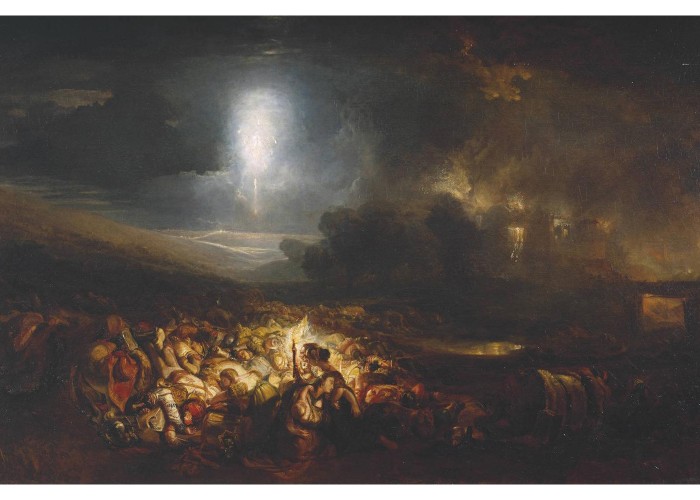The Field of Waterloo, Joseph Turner
This painting, by the great 19th century artist Joseph Mallord William Turner, depicts the battlefield of Waterloo and the terrible casualties inflicted during the fighting. The aftermath of Waterloo held a morbid fascination for many artists, providing as it did a terrible spectacle and a scene of human suffering that rather fitted the moralising and sentimental attitudes of the age.
The carnage caused by the Battle of Waterloo was exceptional, even for a period of bloody combat and poor medical service. Over one-third of the approximately 191,000 soldiers who fought were killed or wounded. One British soldier, John Kincaid, said: “I never heard of a battle in which everyone was killed, but this seems likely to be an exception.” After the battle, the fields of Waterloo were covered with tens of thousands of the dead and dying.
This scene perhaps appealed partly for the dramatic and artistic effects, as shown by Turner’s use of light and shade in this painting. However, depictions of Waterloo such as this also involved considerable amounts of study, in order to ensure that the finished piece was as accurate as possible.
In preparation for this scene, Turner travelled to the battlefield in 1817 and made a number of sketches. The location of these sketches – which were made in daylight and are thus rather easier to locate on the battlefield than the finished night-time composition – suggests that this scene is intended to represent the area immediately to the east of Hougoumont farm, the shadowy outline of which can be seen on the right of the painting. This was the scene of some of the heaviest fighting, being that portion of the allied lines that was attacked by both the French heavy cavalry and the Imperial Guard. British officer William Hay, who crossed this area as his regiment advanced at the end of the battle, wrote that “bodies were lying so close to each other that our horses could scarcely advance without trampling on them, and a great many were wounded in the fetlocks from the bayonets and other weapons that were scattered about on the field”.
The scene as Turner presents it is lit by an electrical storm, spotlighting parts of the field and leaving others in near darkness. Just as Hay described, the bodies of the fallen are so tightly packed it is hard to distinguish where one ends and another starts, and it is often impossible to distinguish which side these men fought on. In the foreground, women are mourning lost loved ones, or else still searching by torchlight for a missing husband or lover. Several have children with them, reinforcing the pathos of the scene and reminding the viewers how deeply the loss of each life would be felt.
When Turner’s picture was eventually unveiled at the Royal Academy in 1818, it was accompanied by a quote from a poem by Lord Byron in the catalogue, summing up the melancholy disillusionment of the scene, ‘Rider and horse—friend, foe, in one red burial blent with war’. Perhaps surprisingly, reviews were mixed. Whilst some praised the picture as ‘a terrific representation of the effects of war’, others derided it as little more than the scene of a ‘drunken hubbub on an illumination night’.
-
Education overview
Sources:
Tate Catalogue details of the painting: http://www.tate.org.uk/art/artworks/turner-the-field-of-waterloo-n00500/text-catalogue-entry
Turner’s watercolour sketch of the field: http://www.gladwellpatterson.com/turner/
Hay, Captain William, Reminiscences 1808-1815 Under Wellington. London, Simpkin, Marshal, Hamilton, Kent, & Co., 1901.
-
Curatorial info
- Originating Museum: http://www.tate.org.uk/art/artworks/turner-the-field-of-waterloo-n00500
- Accession Number: N00500
- Production Date: 1817
- Creator: J.M.W. Turner
- Technique: Oil painting
- Size: 1860 x 2773 x 180 mm
-
Use this image
You can download and use the high resolution image for use in a non-profit environment such as a school or college, but please take note of the license type and rights holder information below
- Rights Holder: Copyright Tate Britain.
- License Type: All Rights Reserved
Find it here
This object is in the collection of Tate Britain







